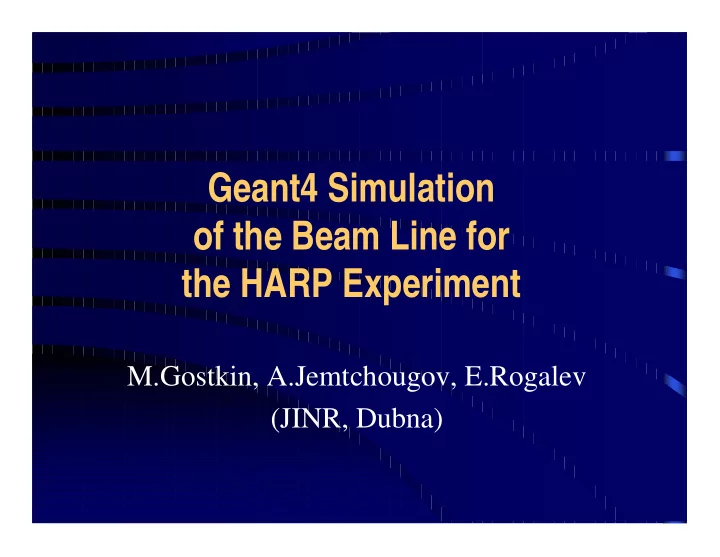

Geant4 Simulation of the Beam Line for the HARP Experiment M.Gostkin, A.Jemtchougov, E.Rogalev (JINR, Dubna)
Why Simulation? • According to the HARP experiment goals it is crucial to have a precise absolute knowledge of the particle rate incident onto the HARP target • Since the beam line is rather long, the number of pion decays will not be negligible, and therefore a reasonable rate of muons can be expected • It is not possible to separate experimentally pions from muons in the beam with the accuracy required A full simulation of the beam line integrated with the full HARP detector simulation must be performed [by J.Panman, P.Zucchelli, Pion Tagging in the T9 beam, HARP Memo-2000-001]
The CERN PS ZT9 Beam Line • Length is about 77.5 m • Momentum range is 2-15 GeV/c (positive or negative beam) • Angular acceptance is less than 5.1 mrad • 9 quadrupole magnets • 4 bending magnets
Challenges Problems to be solved Features of the beam line • Accurate positioning • Sophisticated geometry of volumes • Very non-uniform (misplacement should be strong magnetic field less than 0.01%) • Magnet optics • Primary target as a simulation and the particle source fine beam line tuning • Primary target simulation
Positioning of the Volumes • To meet the accuracy requirements PS survey data should be used to calculate positions and rotations of the beam equipment (magnets, collimators etc.) • The method to transfer the survey data to the Geant4 geometry constructor is required
Magnet Optics Simulation (I) • Placement of magnets and non-uniformity of their magnetic field in general case makes difficulties of using Geant4 master reference system • Description of the magnetic field in terms of local reference system associated with the magnet is more convenient
Magnet Optics Simulation (II) • The total length of all magnets of the beam line is about 1/3 of the beam line length only • Implementation of magnetic field in the entire world volume makes computation rate two times slower, because the equation of motion is solved on each step even if the field value is zero • The method of switching field on inside the magnets and switching it off elsewhere is desirable
OO Approach to the Beam Line Simulation • OO design of beam line is the most natural in Geant4 simulation ! • All beam line elements (magnet lenses, collimators, etc) are the objects • A separate base class is designed to position the volumes using PS survey data. All the classes describing the beam line elements are inherited from this base class • All the classes describing the magnets are inherited from the G4MagneticField class to allow calculation of magnetic field locally
Magnetic Field Management • The method invoked in UserSteppingAction checks the existence of magnetic field at the given point • If field exists, the method returns pointer to the object, which is responsible for the field at the specified point, or NULL pointer otherwise • The field is switched near the boundary of the magnet gap. If the volume boundary and the field one coincide, an instability of Geant4 tracking occurs • The field is calculated in local coordinates of the magnet by means of G4Navigator methods
Primary Particle Generator • Direct simulation of the primary target simultaneously with the beam line simulation is extremely ineffective, because of the small angular acceptance of the beam line • Instead of this, the standalone primary target simulation has been carried out • The results of this simulation have been used in the primary particle generator, to produce a beam with angular spread in accordance with the beam line acceptance
Results According to the beam line simulation goal, the next results have been obtained as a preliminary: - beam composition vs. beam momentum at the HARP target - beam composition vs. geometry position at the HARP target - beam spot position and dimensions at focus to compare with experimental data. The simulation results are in good correspondence with measurements: Simulation (10 GeV/c) Measurement Beam spot width (mm) 3.27 approx. 4 Beam spot height (mm) 3.49 approx. 4 Beam spot position (mm) (0.33:0.86) (0.0:0.0)
Beam profile and composition at the HARP target Results (I)
Results (II) Beam profile and composition at the HARP target
Results (III) Muon background at the HARP target
Results (IV) Muon background at the HARP target
Results (V) Beam composition vs. beam momentum
Performance • Computation rate is about 40000 events per hour (Pentium III, 866MHz, Linux ) • Transportation efficiency is in range of 70-85% in dependence on beam momentum. It is very close to the real life • Focus position, beam spot dimensions and values of current in magnet coil are in good correspondence with practice
Summary • Beam line simulation has been carried out. Beam composition and muon background at the HARP target has been investigated. According to the spot check, the results obtained are in good correspondence with experimental data • OO approach to the simulation of beam equipment is natural in Geant4 simulation and allows to take all advantages of C++ • Association of magnetic field with volumes made the code simple and effective
Recommend
More recommend